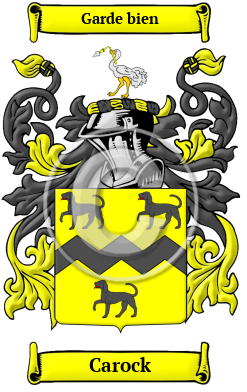| ![Show Contents]() Carock History, Family Crest & Coats of Arms Carock History, Family Crest & Coats of Arms
Etymology of CarockWhat does the name Carock mean? The roots of the Carock family stretch back to the Strathclyde people of the Scottish/English Borderlands, who were the first to use the surname. It is derived from the personal name Craig. Thus, Carock is a patronymic name, taken from the given name of the father or some other ancestor of the bearer. However, Carock may also be of local origin, referring to those who lived in or near the place called Carrick in Ayrshire. 1 The name could have also been derived from the Gaelic, "carraig" meaning "rock." 2 Early Origins of the Carock familyThe surname Carock was first found in Ayrshire (Gaelic: Siorrachd Inbhir Àir), formerly a county in the southwestern Strathclyde region of Scotland, that today makes up the Council Areas of South, East, and North Ayrshire, and were known as 'the men of Carrick'. Duncan de Carrick (died 1250) was made the Mormaer (Earl) of Carrick by Scottish King Alexander I in 1186. He was a direct ancestor Robert the Bruce (Robert I), King of the Scots 1274-1329. Mestre Duncan de Carrike of county of Berewyke rendered homage to King Edward I of England in 1296. 1 Early History of the Carock familyThis web page shows only a small excerpt of our Carock research. Another 252 words (18 lines of text) covering the years 1224, 1296, 1320, 1360, 1370, 1371, 1372, 1380, 1429, 1554, 1606, 1665, 1716, 1717, 1779 and 1820 are included under the topic Early Carock History in all our PDF Extended History products and printed products wherever possible. Carock Spelling VariationsThe variation in the spelling of Medieval names is a result of the lack of spelling rules in the English language prior to the last few hundred years. Before that time, scribes spelled according to sound, often varying the spelling of name within a single document. Carock has appeared as Carrick, Carick, Carich, Carrich, Karryck, Karrik, Karrick, Kerrich, Kerrick, Carrig, Carrigy, McCarrigy and many more. Early Notables of the Carock familyNotable amongst the family at this time was John de Carrick (died c. 1380), a native of Carrick, Scotland, Chancellor of Scotland and Bishop-elect of Dunkeld (1370-1371.)David Garrick (1717-1779)...
Another 28 words (2 lines of text) are included under the topic Early Carock Notables in all our PDF Extended History products and printed products wherever possible. Migration of the Carock family to IrelandSome of the Carock family moved to Ireland, but this topic is not covered in this excerpt. More information about their life in Ireland is included in all our PDF Extended History products and printed products wherever possible. Migration of the Carock familyAs the persecution of Clan families continued, they sailed for North America in increasing numbers. In most cases, they found the freedom and opportunity they sought. Land was often available and the American War of Independence allowed Scots an opportunity to solidify their independence from the English crown. These settlers and their ancestors went on to play essential roles in the forging of the nations of the United States and Canada. Among them: Richard Carrick, who arrived in Virginia in 1650; Roger Carrick, who came to Virginia in 1672; Christian Carrick, a bonded passenger, who came to America in 1758.
The motto was originally a war cry or slogan. Mottoes first began to be shown with arms in the 14th and 15th centuries, but were not in general use until the 17th century. Thus the oldest coats of arms generally do not include a motto. Mottoes seldom form part of the grant of arms: Under most heraldic authorities, a motto is an optional component of the coat of arms, and can be added to or changed at will; many families have chosen not to display a motto.
Motto: Garde bien
Motto Translation: Watch well.
- Black, George F., The Surnames of Scotland Their Origin, Meaning and History. New York: New York Public Library, 1946. Print. (ISBN 0-87104-172-3)
- Bardsley, C.W, A Dictionary of English and Welsh Surnames: With Special American Instances. Wiltshire: Heraldry Today, 1901. Print. (ISBN 0-900455-44-6)
 |

